BIBLIOGRAPHIE
A.J.E.I: Association Jeunes Etudes Indiennes., 2005. La
restitution des données dans la recherche en sciences sociales.
Techniques et enjeux. New Delhi: edition de l'AJEI. 204 p.
CAPRON G., CORTES G., GUETAT-BERNARD H., 2005. Liens et lieux de
la mobilité. Ces autres territoires. Paris : Belin. 343 p.
LANDY F., 2002. L'union indienne. Nantes : Editions du temps. 287
p.
LE TELLIER J., 2005 . Les grands taxis : approche du
système de transport et de la mobilité au Maroc. Annales de
Géographie, vol 642. Pages 163 à 186.
LEVY J. & LUSSAULT M.,2003. Dictionnaire de la
géographie et de l'espace des sociétés. Paris : Belin.
1033 p.
LOMBARD J., SAKHO P., BRUEZ F., BAILLON A., 2004. Les rues de
Dakar : espace de négociation des transports collectifs. Autrepart (32).
P. 115 à 133.
MITRA S., 2006. City Transport in India, impending disaster.
Economic and Political Weekly. Vol 463.
POLESE M. & WOLFE M-J., 1995. L'urbanisation des pays en
développement. Paris.
Economica, Groupe Interuniversitaire de Montréal, Villes
et Développement. 529 p.
RAM MOHAN RAO & SIMHADRI S.,1994. Indian cities: Towards next
millennium. RASTOGI A., 2006. Urban infrastructure report 2006. New Delhi:
Oxford University
Press. 257 p.
SHAMSHER S., 1992. Urban Planning and Development: Issues and
imperatives.
SIVARAMAKRISHNAN K. C. & KUNDU AMITHAB & SINGH B.N.,
2005. Handbook of urbanisation in India. New Delhi: Oxford University Press.
177 p.
SRINIVASAN S. ROGERS P., 2005, Travel behaviour of low-income
residents: studying two contrasting locations in the city of Chennai, India.
Journal of transport geography, volume 13. p 265 à 274.
TACOLI C., 1998. Rural-Urban Interactions: Guide to the
Literature. Environment and Urbanization, vol 10 (1). Pages 147 à
166.
CD-ROM: Census of India, 1991
CD-ROM: Census of India,
2001
WEBO GRAPHIE
Institut Français de Pondichéry. Peri-Urban
Dynamics.
http://www.ifpindia/Peri-urban-dynamics.html.
Visité le 11/03/06
Institut Français de Pondichéry. Urban Dynamics.
http://www.ifpindia/Urban-Dynamics.html.
Visité le 11/03/06.
Map of India
www.mapofindia.com visité
le 14/03/06
ONU - Charte du millénaire
http://www.un.org/french/
visité le 23/05/06
Banque mondiale http://www.banquemondiale.org/
visité le 08/04/06
PNUD - Programme des Nations-Unies pour le développement
http://www.undp.org/french/
visité le 12/04/06
NHDP - National Highway Development Project
http://www.nhai.org/
visité le 12/04/06
CMDA - Chennai Metropolitan Development Authority
http://www.cmdachennai.org/english/index.htm
visité le 10/02/06
ANNEXES

Annexe 1: part du budget 2006 réservée au
secteur des transports publié dans The
Hindu.
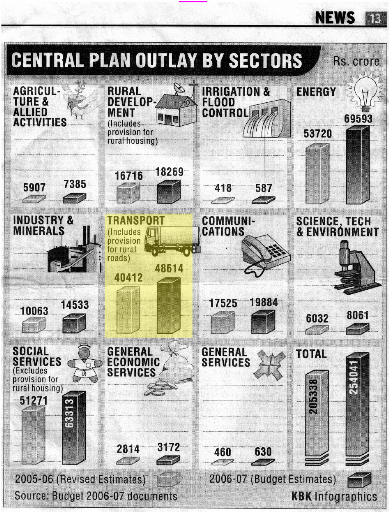
Annexe 2: Questionnaire d'enquête sur les
mobilités villageoises :
SURVEY TRANSPORT AND MOBILITY IN
MEDAVAKKAM
Nom du quartier, de la rue, localisation, remarques:
Identity :
- Age
- Religion
- Caste
- If you are a migrant, place of origin :
Work:
- Do you have a job?
- What kind of job? (indicate the activity)
- Is it a home job?
- If not (answer the following questions):
-Where is it? (name of the place)
- How far is it from your house?
- How do you go to your work?
Bus of the firm/Public bus/Auto rickshaw/Share rickshaw/
Maxi-cab/Car/Motorized two-wheeler/Bicycle/Walk/Other
Weekly or monthly outings:
- Do you go to the temple, the church or mosque?
- Where is it? How far from your house?
- How do you go?
Bus of the firm/Public bus/Auto rickshaw/Share rickshaw/
Maxi-cab/Car/Motorized two-wheeler/Bicycle/Walk/Other - How often do you go?
- Do you go on pilgrimage? How? Where? How often?
- Do you go to the market?
- Where is it?
- How often do you go?
- How do go?
Bus of the firm/Public bus/Auto rickshaw/Share rickshaw/
Maxi-cab/Car/Motorized two-wheeler/Bicycle/Walk/Other
- Where do you go to purchase occasional goods? - How far from
your house?
- How often do you go?
- How do you go?
Bus of the firm/Public bus/Auto rickshaw/Share rickshaw/
Maxi-cab/Car/Motorized two-wheeler/Bicycle/Walk/Other
- Do you usually go to any other place weekly or monthly (leave
Medavakkam)?
- Where is it?
- How often do you go?
- How do you go?
Bus of the firm/Public bus/Auto rickshaw/Share rickshaw/
Maxi-cab/Car/Motorized two-wheeler/Bicycle/Walk/Other
Opinion:
- Why do you use mass transport (public bus) (only if the people
use mass transport)?
- What do you think about the quality of mass transport? - Do you
want to change your way of transport?
Annexe 3:
QUESTIONNAIRE D'ENQUETE AUPRES DES CHAUFFEURS DE
RICKSHAWS
Identité :
- Age :
- Religion :
- Caste :
- Si vous n'êtes pas originaire de Medavakkam, dans quelle
ville êtes vous né ?
- Ou vivez-vous actuellement ?
Profession :
- Êtes-vous propriétaire de votre rickshaw ?
- Si non, a qui appartient t-il ?
- Travaillez-vous seul sur ce rickshaw ?
- Si non, combien de personnes travaillent sur ce rickshaw ? - Si
oui, comment l'avez-vous acheté (crédit, emprunt, fond
personnel...) ?
- Quels sont vos horaires de travail ?
Distance et mobilité :
- Avez-vous un secteur donné pour travailler, si ou lequel
?
- Combien de kilomètres parcourez-vous en moyenne dans la
journée ?
- Quelles sont vos principales destinations ?
- Combien de courses effectuez-vous par jour en moyenne ?
Gains, rentabilité :
- Quelle est votre consommation hebdomadaire moyenne d'essence
(en litre et en roupies) ?
- Quel est le prix moyen d'une course ?
- Quel est votre salaire moyen journalier ?
- Fournissez-vous le salaire principal de votre foyer ?
Habitudes liées à la profession :
- Qui s'occupe de l'entretien du véhicule ?
- Souhaiteriez-vous améliorer votre véhicule ou en
changer ?
Opinion sur les conditions de travail :
- Êtes-vous satisfait de votre travail ? Pourquoi ?
Aimeriez-vous en changer ?
- Pensez vous que le nombre de rickshaws soit trop important, en
général et à Medavakkam ?
- Que pensez-vous de l'état des routes ?
- Que pensez-vous de l'état de la circulation dans Chennai
et ici ? - Quels problèmes rencontrez-vous dans l'exercice de votre
profession ?
- Avez-vous déjà eu un accident ? Pensez vous que
le rickshaws soit un véhicule sur ?
Lien avec Chennai :
- Voudriez-vous travailler au centre de l'agglomération de
Chennai ? Pourquoi ?
- Vous rendez vous à Chennai ? Si oui, combien de trajets
jusqu'à
Chennai réalisez vous chaque jours ?
- Considérez vous que Medavakkam fasse partie de la ville
de Chennai ?
- Quelles sont les heures d'affluence maximum sur la route qui
relie Medavakkam à Chennai ?
Annexes photographiques :
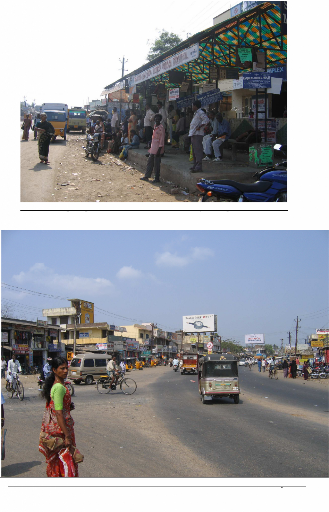
L'arrêt de bus principal de Medavakkam sur la Velachery
Road qui mène à Chennai
Medavakkam Junction, au carrefour de la Perumbakkam Main Road
et de la Velachery Road.
83
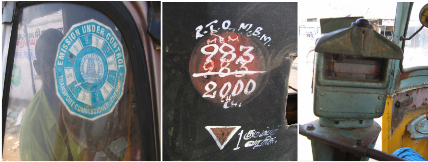
Le macaron de contrôle de pollution, le numéro de
licence et le compteur d'un rickshaw
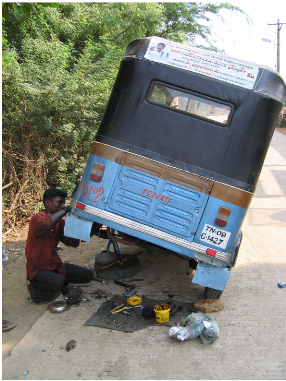
Un private-rickshaw en réparation
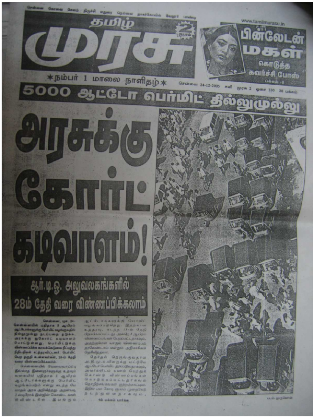
Dans les archives de la SISTEU, un article sur les piquets
de grèves
lancés par les syndicats des chauffeurs
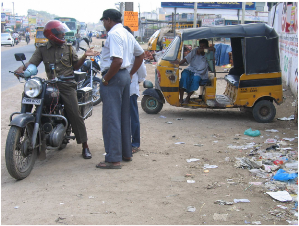
Un agent de police réprimandant un rickshaw men mal
stationné
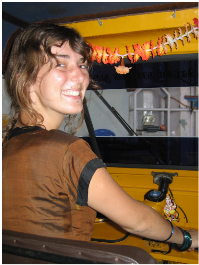
Une preuve de la maniabilité du rickshaw !
| 



